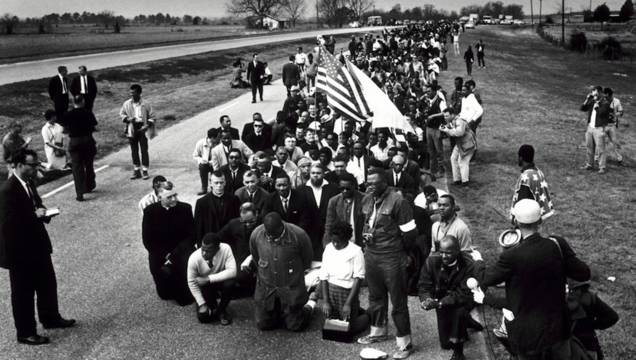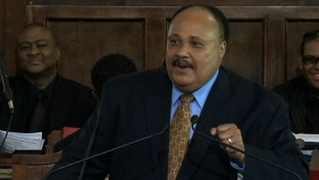
Thirty-five years ago today, on March 7, 1965, Alabama State troopers attacked 600 black men, women and children who were marching for their right to vote. Armed with nightsticks and tear gas, the troopers turned back the protesters — including Dr. Martin Luther King, Jr. — who were marching from Selma to Montgomery. Televised images of the brutality shocked the nation and the world and helped spur the 1965 Voting Rights Act and the further breakdown of segregationist laws.
Thousands gathered this Sunday with President Clinton and Rev. Jesse Jackson to commemorate the march. Last year, Democracy Now! technical director Errol Maitland spoke with Joanne Bland, resident historian of the Voting Rights Museum in Selma. They were at the foot of the Edmund Pettus Bridge, which became an icon of the civil rights movement. [includes rush transcript]
Transcript
AMY GOODMAN: Thirty-five years ago today, on March 7th, 1965, Alabama state troopers attacked 600 black men, women and children as they marched for their right to vote. The sheriff’s deputies and state troopers used nightsticks and tear gas on the marchers led by the Reverend Martin Luther King, as they tried to make their way from Selma to Montgomery. Televised images of the brutality shocked the nation and helped spur the 1965 Voting Rights Act. Thousands gathered on Sunday with President Clinton and the Reverend Jesse Jackson to commemorate the march.
Well, last year, Democracy Now! technical director Errol Maitland went down to Selma, and he spoke with Joanne Bland, resident historian of the Voting Rights Museum, as they sat in the museum at the foot of the Edmund Pettus Bridge, which has become an icon of the civil rights movement, and Joanne Bland remembered that day, March 7th, 1965.
JOANNE BLAND: We left Brown Chapel AME Church, going to the bridge, coming to the bridge, thinking that we were doing a symbolic march. It wasn’t supposed to go to Montgomery in the first place, that they knew that it wouldn’t. It was supposed to be a symbolic thing, that we’d go and then we’d turn around and come back. But it didn’t happen that way.
When we got to the bridge, I was in the middle of the bridge when all of a sudden they started to kneel and pray. But the men in the group came and crowded — put all the women in the middle. That was my first inkling that something was wrong, that something bad was going to happen, because that had never happened before, and I had been on hundreds of marches. And by the time we all kneeled down, I heard what I thought were gunshots and screams. So I thought they were killing the people up front, they were just shooting them. And by the time we got up enough to see what was happening, it was like the domino effect. The people from the front were running back, and people on horses were riding and beating people. Horses were stepping on people. Even coming back, the troopers had on a gas mask. But at that time I didn’t know what a gas mask was. So there were these monsters in uniform running toward us, running toward us, beating people unmercifully.
The last thing I remember on the bridge was a horse. This man had come over the hill, and he was just beating people, just hitting anybody, and the horse bumped this lady, and she fell down. And the horse reared up, and when it came down, its hoof came down on her arm, and it broke it. And the bone came through here, and blood just went up like a fountain. It’s the last thing I remember until I woke up on this side of the bridge in the back of a car.
And my sister — Mrs. Jefferson and her husband were the people who were tending me. And when I awakened, Mrs. Jefferson found my sister somehow in the crowd and brought her to me. And she was covered with blood. Her shirt, her whole face was in stripes. It was just horrible. And she eventually had 37 stitches in the back of her head where she had been hit. You could see her getting hit in Eyes on the Prize. It’s quite vivid. She’s a little girl with a white coat on, and they’re beating her, and she’s trying to get away.
But we went back to the church. We got to the church. They ran us out of the church. The same thing happened at the church, except we didn’t have tear gas at the church. They just came in and started beating people. And I felt a hopelessness then, because I felt like nothing was sacred, nothing was safe. We were not safe anymore, because they came into our churches and did this. They came into the church and did this. Nobody could save us, even God. You know, we were just done and doomed.
ERROL MAITLAND: Have you seen, in your lifetime, tangible changes that have happened, that have occurred, that are positive, that came about as a result of your trying to march across that bridge, of your being arrested over and over and thrown in jail from the age of eleven years old?
JOANNE BLAND: Yes. I think it’s important, especially to our children, that they know that we’ve made gains, that all these struggles have not been in vain. For one thing, now I live in a neighborhood I could never have walked in. Our people own houses in neighborhoods they could never go in. Our children go to school together, and some of our schools are half and half. Those are our better schools. The predominantly black schools are just terrible. They lack in money. OK, I’ve seen my councilwoman. The faces change. I’ve seen a black female on the panel. I’ve seen things happen in our community that would never, ever happen. We own businesses now. That did change.
ERROL MAITLAND: Do we own more businesses now than we did back in 1965?
JOANNE BLAND: Oh, big time, especially here in Selma. Our main street is Broad Street. You would never have seen a black business on Broad Street in '65. Nothing was there but whites, period. You were not even allowed to — if you could even think about buying, you wouldn't even — it never crossed your mind to think about buying a business or building on Broad Street.
AMY GOODMAN: Joanne Bland is the resident historian at the Voting Rights Museum at the foot of the Edmund Pettus Bridge, a symbol of the civil rights struggle, where 35 years ago today more than 600 marchers for equality and voting rights — black men, women and children — were beaten by Alabama state troopers and sheriff’s deputies.












Media Options